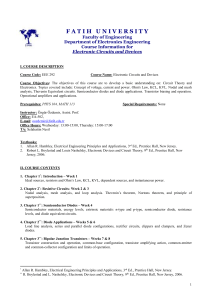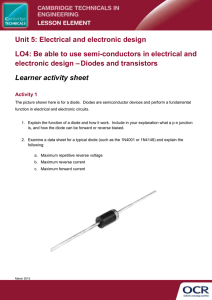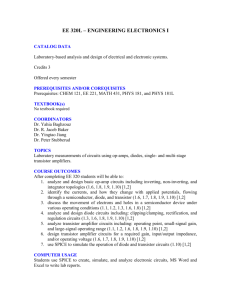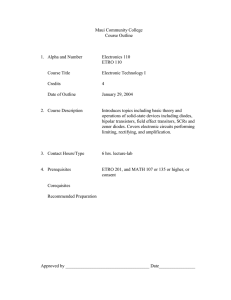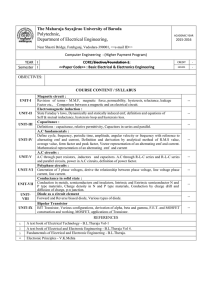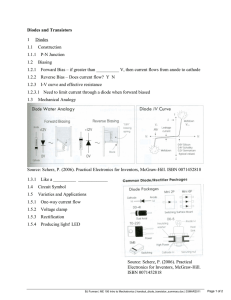Non-Linear Circuits
advertisement
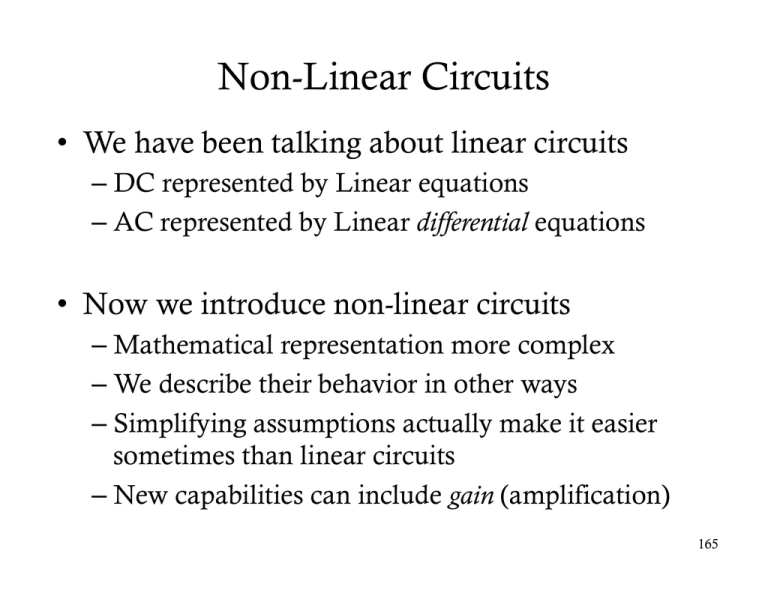
Non-Linear Circuits • We have been talking about linear circuits – DC represented by Linear equations – AC represented by Linear differential equations • Now we introduce non-linear circuits – Mathematical representation more complex – We describe their behavior in other ways – Simplifying assumptions actually make it easier sometimes than linear circuits – New capabilities can include gain (amplification) 165 Diode we’ve seen the diode once already, shorting out the surge in a coil. 166 carrier (extra electron) hole (missing electron) semiconductor (covalent) Little piece of the period Table most commercial solid-state devices Valance group 3 4 5 some more exotic devices 167 Diode acts as a one-way valve 168 Graphical Representation on V-I Plane Ideal Diode Real Diode infinite conductance infinite resistance • Forward biased current is exponentially related to voltage, asymptotes to 0.5-0.7 V for silicon, ~0.2V for germanium. • Reverse biased current is zero until “reverse breakdown voltage. 169 Light Emitting Diode (LED) • Forward bias voltage is higher and varies with color, according to E = hυ 170 Zener Diode Zener worked at CMU 171 Can solve circuits graphically on V-I graph • Zener points into the current and is purposefully biased in the reverse breakdown region. • Like pressure regulator on a SCUBA tank. 172 Diode as Peak Detector • Keeps a running maximum • Need resistor to “reset” peak detector – Otherwise it gives highest voltage since beginning of time 173 Rectification • Turns AC into DC • Half-Wave Rectification • Full-Wave Rectification 174 Voltage Doubler no connection where lines cross but no dot… 175 Amplitude Modulation (AM) radio receiver Invented by Reginald Fessenden, Chair EE U. Pitt. 176 Varactor (variable capacitor diode) 177 Logic with Diodes • When A is at 5V its diode is forward biased. • If B is then at 0V, its diode is reverse biased, preventing it from bringing the output down. 178 Before solid state there were vacuum tube diodes. 179 Triodes - Amplification 180 These are Bipolar Transistors (vs. Field Effect Transistors, which we’ll see later). 181 182 Transistor Circuits: Common Emitter note: transistors often drawn without circle 183 Transistor Circuits: Emitter Follower 184 • Transistors operate in 1 of 3 regions: – Biased (active) : IC = βIB independent of VCE , where β is constant for a given transistor (50<β<250 for our 2N3904). – Cutoff : transistor is effectively turned off when IB is too small. – Saturation : transistor is “wide open” with the current limited elsewhere in the circuit. IC = β I B 185 Transistor in the saturated region • • • • IB = 1 mA so IC should be 100 mA, making VCE = − 90 V! Transistor is not a source of energy and can’t do that. So transistor is wide open, with current limited elsewhere. VCE settles below the “biased” region, in effect a short circuit doing the best it can. 186 Example: Emitter Follower as “Buffered” Voltage Source Vout acts more like a perfect voltage source because transistor supplies more current as needed 187 Bistable (Flip Flop) 188 We would like to build amplifiers whose gain only depends on linear components like resistors. 189 Classic Audio Amplifier 190 1 mA Current Source Assumes VBE = 0.6 V 191 Darlington Transistor (two transistors in one) 192 Gain • Previous circuits (with resistors, capacitors, coils, and diodes) had one stable equilibrium. • Transistors add gain, the ability to control a large voltage or current with a smaller voltage or current. • This leads to bistable and unstable circuits. • We will demonstrate this next with relays, which are magnetically activated switches. 193 Switches and Relays 194 More Switches 195 Relays • Like transistors, relays introduce gain. • Gain permits circuits that are either: Bistable (with memory) or Unstable (that oscillate) 196 Bistable Relay Circuit • the Latch – Positive feedback: maintains its present state, whichever it is (memory) 197 Unstable Relay Circuit • the Buzzer – Negative feedback: changes its present state to the other (oscillator, though negative feedback stabilizes to a single equilibrium in some systems, e.g. emitter follower) 198 Unstable (Multivibrator) With Q1 on, C1 charges, until base of Q2 high enough to turn on. For animation see www.falstad.com/circuit/e-multivib-a.html 199 Thermistor • All resistors have temperature coefficient, usually considered bad. • Bug becomes feature. 200 Photoresistor • Cadmium sulfide between electrodes. • Photons create free electrons. 201 Photodiodes • Faster and more sensitive than photoresistors • Two modes: – Photoconductive vs. Photovoltaic 202 Photodiodes 203 Phototransistors • Faster than photodiodes 204 Optical Isolation 205 Fiber Optics http://www.allaboutcircuits.com/ textbook/digital/chpt-14/opticaldata-communication/ 206
